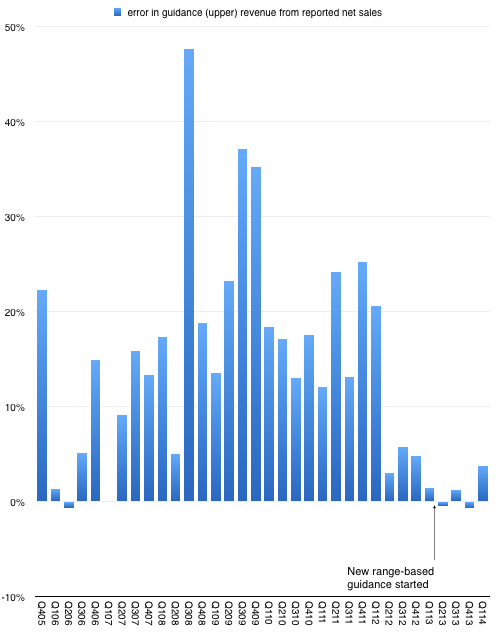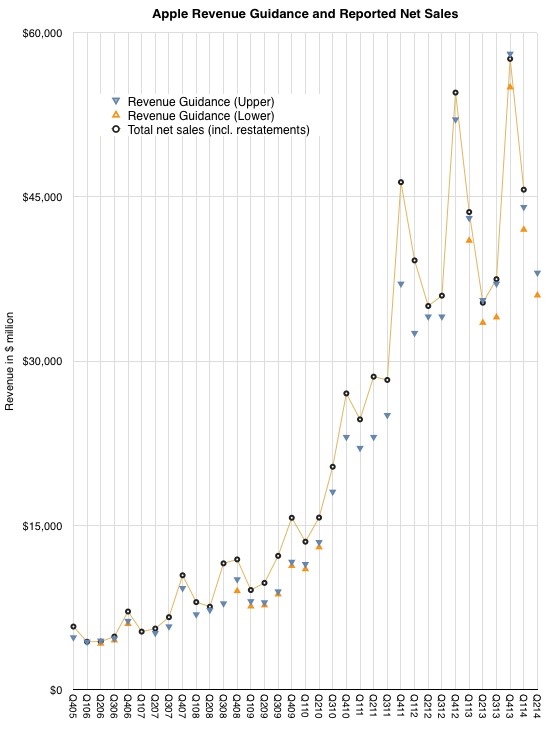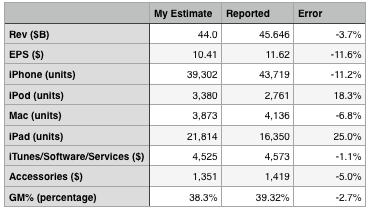How to behave in Apple shares after the release of new devices
 Bashny.Net
Bashny.Net
After a certain number of fiscal quarters c predictable results, Apple surprised its sales figures, which are 3, 74% higher than the expected forecast [ the original article published in the 2nd quarter of 2014 - approx. pens i>.]. This may not seem so important, but as long as the company in the first quarter of last year introduced a new methodology for forecasting, announced the company's revenue by approximately 1% higher than the previously established limit.
This is in stark contrast with the values of indicators of previous years. Below is a graph that shows the "error" in the forecast as a percentage of the difference between ad sales and predictable. [1]

By clicking the image to open in full size i>
So, until the last quarter, we mistakenly believed that the prognosis with almost perfect accuracy determines the future of the company. As I wrote on Twitter, because of this, making forecasts for Apple lost its excitement. All you had to do analytics - is to take the growth rates of the main product, allowing to achieve the indicative volume of sales, and then subtract the operating expenses (indicators which kindly provided by the company), and the tax rate (also kindly provided) to get the amount of profit. The only hitherto unknown quantity in the determination of the profit per share - the number of the remaining outstanding shares. [2]
Knowing Apple, I can say that the average selling price is also very rigidly fixed so that the degree of freedom of the analysis becomes extremely limited.
But in that moment when you feel that you understand how the system works, it changes. The company was surprised with the results of activity of the analyst. The graph below shows the estimated range and the actual income received. [3]

What happened? H4> It seems that the answer - improved sales of iPhone. The following table shows my expectations, which were built in accordance with the measure of profitability is at the top of the forecast range.
The top edge of the range in those neighborhoods, which shows the range of fluctuations. The company itself can not know what will be the number of shares outstanding, as their purchase during the quarter unplanned happens. The next quarter is also taken into account. < br />
The link is located Horace Dediu interview about surprises in the market after the release of the new iPad, which he gave to Bloomberg reporters in October 2014: www.bloomberg.com/video/apple-s-ipad-unveil-were-there-any-surprises-bqKlwc4sSqCSupwehzbsJA.html [En].
posts and related links:
Statistics: why you should not buy stocks after the release of the new Apple iPhone How to buy stocks of IT companies before, during and after the IPO IPO concern Alibaba: what actually will buy investors Analytical materials about the stock market
Source: habrahabr.ru/company/itinvest/blog/241189/
This is in stark contrast with the values of indicators of previous years. Below is a graph that shows the "error" in the forecast as a percentage of the difference between ad sales and predictable. [1]

By clicking the image to open in full size i>
So, until the last quarter, we mistakenly believed that the prognosis with almost perfect accuracy determines the future of the company. As I wrote on Twitter, because of this, making forecasts for Apple lost its excitement. All you had to do analytics - is to take the growth rates of the main product, allowing to achieve the indicative volume of sales, and then subtract the operating expenses (indicators which kindly provided by the company), and the tax rate (also kindly provided) to get the amount of profit. The only hitherto unknown quantity in the determination of the profit per share - the number of the remaining outstanding shares. [2]
Knowing Apple, I can say that the average selling price is also very rigidly fixed so that the degree of freedom of the analysis becomes extremely limited.
But in that moment when you feel that you understand how the system works, it changes. The company was surprised with the results of activity of the analyst. The graph below shows the estimated range and the actual income received. [3]

What happened? H4> It seems that the answer - improved sales of iPhone. The following table shows my expectations, which were built in accordance with the measure of profitability is at the top of the forecast range.

Regarding deliveries / sales I underestimated the iPhone and Mac, and overestimated the iPad and iPod. I certainly appreciated the iTunes and accessories sale underestimated by 5%. Also, by and large, I'm very close determined the level of profitability, however, pointed to the 1 point less in gross profit.
The conclusion was that the unexpected level of revenue and profits attributable to the significant outperformance selling iPhone, which could compensate for the less significant noncompliance targets for iPod.
IPhone sales rose by 14% - that was enough to compensate for the drop in sales of 13% iPad and allow total revenue to grow by 5%. Since the company did not count on a growth spurt, the 5% was a big surprise.
Someone may ask whether the increase in sales will cause the iPhone to 14% of significant changes in long-term product development strategy. This is a difficult question. The way to position iPhone, making it a success in the premium segment of the market, but do not put in competition with the expectation of 80% of the market, which, apparently, formed c point of view of lower prices.
Still, let's not forget that the pricing is correlated with the market, but not determined by them. Purchasing decision - a complex process, and the price is only one aspect influencing the decision. But there are many other factors. The availability of the goods, channels of communication, service, brand - it all counts. The mistake many analysts is that they believe if the price and only the price affects the behavior of the buyer. Maybe what happens in relation to a commodity, but let me remind you that these products are new, and they started using recently, and the perception of their value quickly changed. Buyers stick learning curve, in the sense of discovery use cases and value of products. Such learning curves can be modeled for a few years (sometimes decades) for many generations between early adopters and late majority.
We do not know exactly where on the learning curve is the iPhone in a particular region, and this means that we can still expect a surprise in the dynamics of its growth.
Note:
The top edge of the range in those neighborhoods, which shows the range of fluctuations. The company itself can not know what will be the number of shares outstanding, as their purchase during the quarter unplanned happens. The next quarter is also taken into account. < br />
The link is located Horace Dediu interview about surprises in the market after the release of the new iPad, which he gave to Bloomberg reporters in October 2014: www.bloomberg.com/video/apple-s-ipad-unveil-were-there-any-surprises-bqKlwc4sSqCSupwehzbsJA.html [En]. posts and related links:
Statistics: why you should not buy stocks after the release of the new Apple iPhone How to buy stocks of IT companies before, during and after the IPO IPO concern Alibaba: what actually will buy investors Analytical materials about the stock market
Source: habrahabr.ru/company/itinvest/blog/241189/
Tags
See also
How to protect yourself from overwork?
Apple iPad in the new building with diamonds.
That the behavior of the drivers in this release "stopham" does not go into any gates. Is it possible?
Colorful evolution of the Apple iPod
Steve Jobs officially introduced the new tablet Apple iPad
New devices for iPad
How to buy stocks of IT companies before, during and after the IPO


















